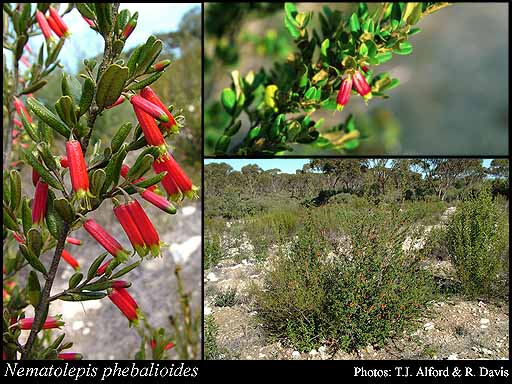- Reference
- Bull.Soc.Imp.Naturalistes Moscou 25 (2):158 (1852)
- Conservation Code
- Not threatened
- Naturalised Status
- Native to Western Australia
- Name Status
- Current
Erect or spreading or straggling shrub, 0.3-3 m high. Fl. red & green/yellow, Mar to Dec. Sandy & clayey soils. Coastal limestone, sand dunes & sandplains, lateritic hills.







Scientific Description
Shrub, spines absent; branchlets smooth, without distinct raised glands, +/- cylindrical in cross-section, covered in hairs or scales, the hairs stellate (star-shaped). Leaves alternate, simple, 7-25 mm long, 3-10 mm wide, flat, the margins flat, verrucose (warty), glabrous; stipular excrescences absent. Flowers axillary, solitary or in axillary, loose clusters (cymes or panicles); pedicels 1.5-4 mm long; calyx present, 1.2-2 mm long, verrucose (warty), glabrous; corolla red, yellow or green, petals five, 10-17 mm long, connate, glabrous; stamens twice as many as petals, 6-15 mm long, smooth, glabrous; anthers 1.4-1.6 mm long, without an appendage. Flowers in March, April, May, June, July, August, September, October, November and December. Occurs in the South-West Botanical Province, in the Avon Wheatbelt, Mallee, Esperance and Swan Coastal Plain IBRA region(s).
Distribution
- IBRA Regions
- Avon Wheatbelt, Esperance Plains, Mallee, Swan Coastal Plain.
- IBRA Subregions
- Eastern Mallee, Fitzgerald, Katanning, Perth, Recherche, Western Mallee.
- IMCRA Regions
- WA South Coast.
- Local Government Areas (LGAs)
- Albany, Dumbleyung, Esperance, Jerramungup, Kent, Ravensthorpe, South Perth.